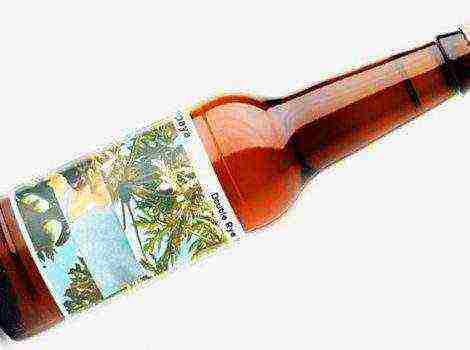Content
White cabbage is an incredibly healthy vegetable with a rich vitamin and mineral composition. This explains its popularity among gardeners. The cultivation rules are not complicated, but the basis for the yield depends on the choice of the variety.
Varietal variety of white cabbage
In the old days, there was really a shortage of seed material due to limited supplies from the near and far abroad, therefore, the seeds were often harvested from the usual varieties.
For more than 20 years, the situation has radically changed, and the varietal assortment of many gardeners continues to consist of 2-3 positions. And in vain, because new developments have no less valuable qualities, which consist in resistance of cabbage to diseases and pests.
This is especially important when you consider that the moisture-loving plant literally attracts insects and fungi.
This article discusses early, mid-season and late-ripening varieties of a popular vegetable with a description that will expand the variety of crops grown in your garden and in the Urals and in the middle lane.
Most Popular
The variety of cabbage is selected not only taking into account the winter and climatic characteristics of the region, but also by appointment... The mineral and vitamin composition of each plant is different, but it is also influenced by the conditions of agricultural technology and the type of soil.
In order to choose the appropriate option it was easier, the varietal assortment is divided into groups, united by a common feature.
The best late varieties of cabbage for long-term storage
Aggressor Is a mid-late hybrid developed by breeders from Holland. Differs in minimal care and resistance to fusarium, thrips damage.
Vegetation lasts up to 120 days, you can sow seeds directly on an open bed. A ripe vegetable weighs 3-5 kg. Shelf life and processing - up to 5 months.
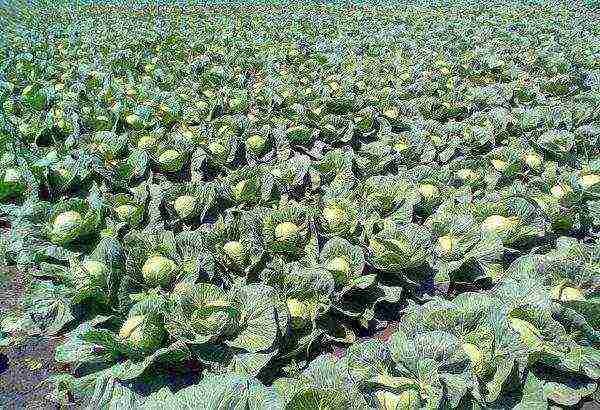 Aggressor
Aggressor
Amager - late cabbage with a ripening period 120-147 days... The heads are round-flat green, sometimes with a bluish tinge, weight about 3-4 kg.
When planting, the scheme is used: 3-4 plants per 1 m2. For six months, the nutritional value and presentation are preserved. Weather cataclysms and violation of the watering regime do not violate the density of the structure and the integrity of the head.
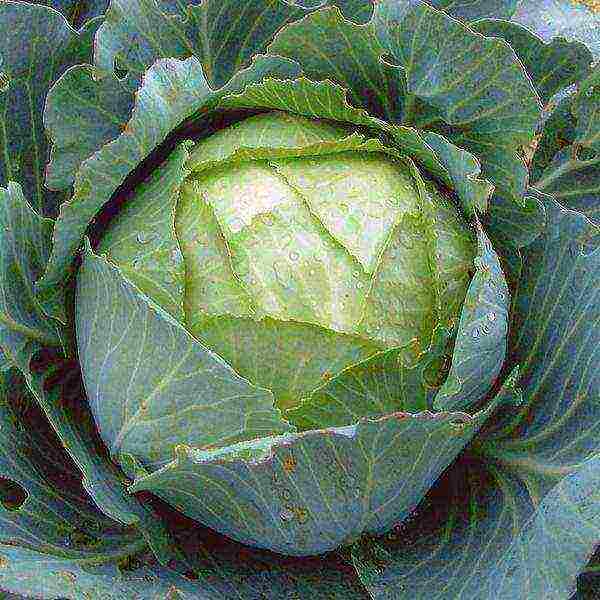 Amager
Amager
Valentine - growing season 155-180 days after transferring seedlings to open beds. The gray-green heads have a slight waxy coating, the weight tightens up to 4 kg.
Cabbage retains its taste and presentation until the beginning of the next season (June). The hybrid is tolerant to fusarium, gray rot. The head of cabbage does not crack due to violations of the moisture regime.
When planting, the scheme is used: 2-4 plants per 1 m2.
 Valentine
Valentine
Gingerbread man - hybrid forms heads later 115-125 days after planting seedlings. Round fruits have a dense structure, the average weight is 2-3 kg. Planting scheme: 3-4 plants per 1 m2.
Due to its good immunity, it exhibits tolerance to punctate necrosis and thrips. For 8-10 months, cabbage retains its nutritional value and presentation.
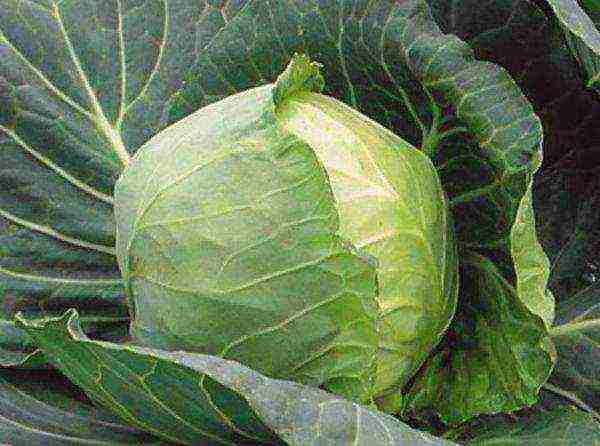 Gingerbread man
Gingerbread man
Mara - very dense heads are not susceptible to cracking, the average weight is 3 kg. The variety is distinguished by good taste, transportability and long shelf life (more than 7 months).
The main advantage is resistance to the accumulation of nitrates and radionuclides. Vegetables are harvested through 160-175 days after transplanting seedlings.
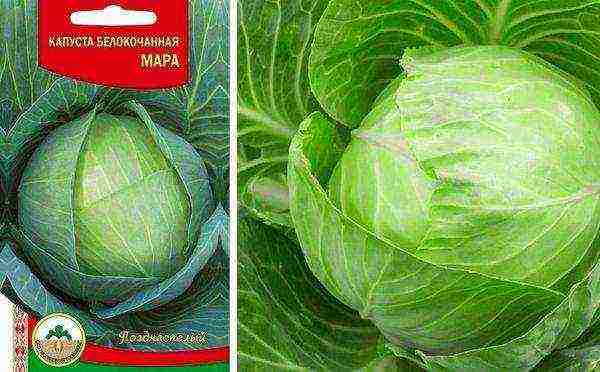 Mara
Mara
Moscow - a variety developed by domestic breeders, who took into account the climatic features and possible problems with pests when growing.
Harvesting begins later 130-140 days after disembarking seedlings. Gray-green rounded heads of cabbage weigh 4-7 kg on average. When planting, the scheme is used: 2-3 plants per 1 m2.
Cabbage is resistant to cracking, has a delicate juicy pulp. Without loss of taste and presentation, the vegetable is stored for 6-8 months.
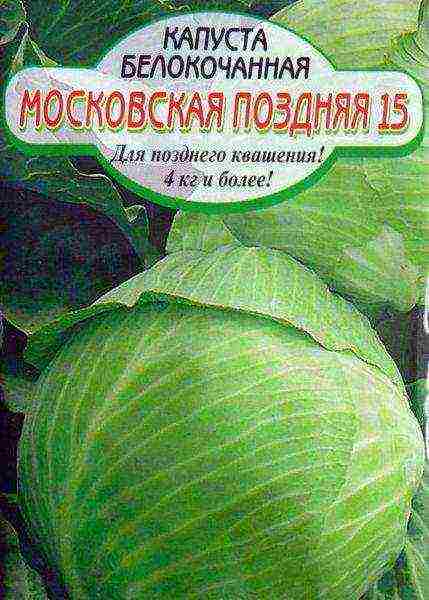 Moscow
Moscow
Mid-season white cabbage
Megaton - the hybrid matures in 102 days after planting seedlings. The great need for moisture and fertilizers strengthens the immune system, which resists many diseases and insect infestations.
The round-flattened gray-green head weighs up to 15 kg. The location of the holes when planting: 3 plants per 1 m2. Duration of storage without loss of nutritional qualities and presentable appearance is 4-6 months.
Merchant's wife - a disease-resistant high-yielding variety, distinguished by simple agricultural technology. About 500 centners are removed from a hectare (head weight up to 3 kg). When planting, the scheme is used: 3-4 plants per 1 m2.
Harvesting begins later 130-150 days after transferring seedlings to the beds.
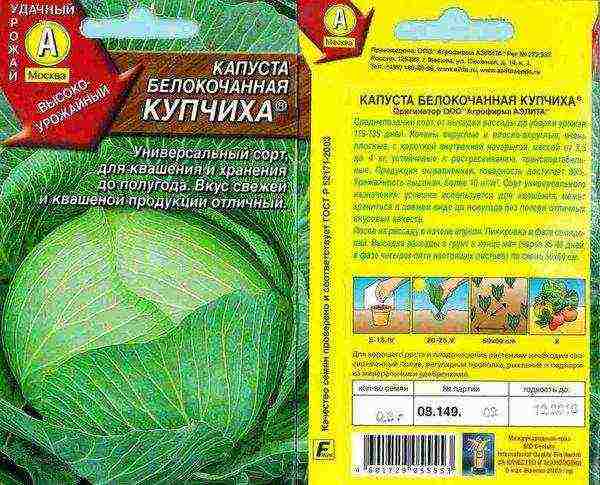 Merchant's wife
Merchant's wife
Atria - the fruit of the works of Dutch breeders with the growing season 110-120 days... The head of cabbage has a round-flat head of blue-green color, the average weight of which reaches 5-7 kg. Often there are specimens of 8-8.5 kg. When planting, the scheme is used: 3 plants per 1 m2.
Thanks to its good immunity, it resists pests (in particular thrips) and fusarium. The commercial and taste qualities are preserved for 4-6 months.
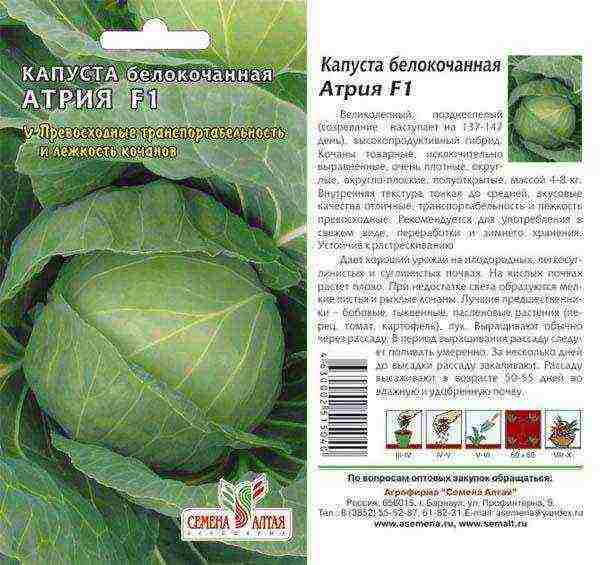 Atria
Atria
Glory - the fruit of the work of Russian breeders, the growing season is 120-130 day after planting seedlings.
Round heads have a light green color with a grayish tinge, the weight tightens up to 3-5 kg. When planting, the holes are arranged according to the scheme: 3-4 plants per 1 m2.
The advantage of the variety is its taste, the disadvantage is short storage (about 2 months). Glory is one of the best pickling options.
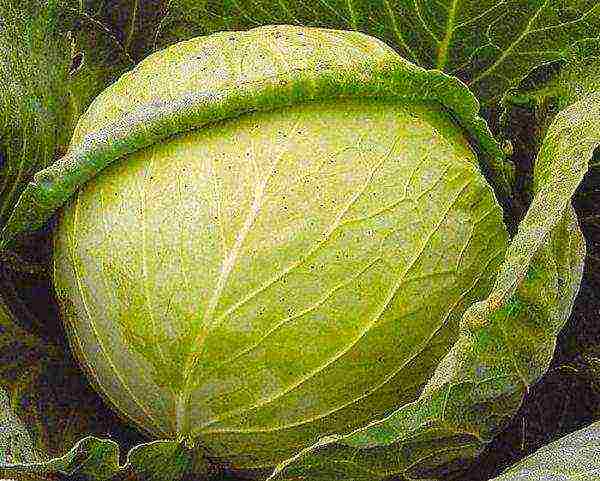 Glory
Glory
Sugar queen - the hybrid ripens after planting seedlings through 120-140 days... Dense rounded heads have a slightly greenish tint, weighing up to 4 kg.
When planting, the scheme is used: 3 plants per 1 m2. The variety is universal, it is used fresh and for salting. The shelf life without loss of valuable qualities is 3-4 months.
 Sugar queen
Sugar queen
Early ripe
Rinda - the ripening period of the hybrid is 75-80 days after disembarking seedlings. Round heads weighing up to 7 kg have a green color and a dense structure. Hole layout: plant 3-5 plants per 1 m2. Differs in unpretentiousness to weather conditions.
The shelf life without loss of taste and presentation does not exceed 4 months.
 Rinda
Rinda
Kazachok - an early hybrid is distinguished by early maturity, you can harvest through 45-55 days after disembarking seedlings. The weight of the medium-sized light green head is 1.5 kg.
The scheme used for planting: 5-6 plants per 1 m2. Recommended for cultivation under any kind of film and in the open field.Cabbage resists the causative agents of mucous bacteriosis and black leg.
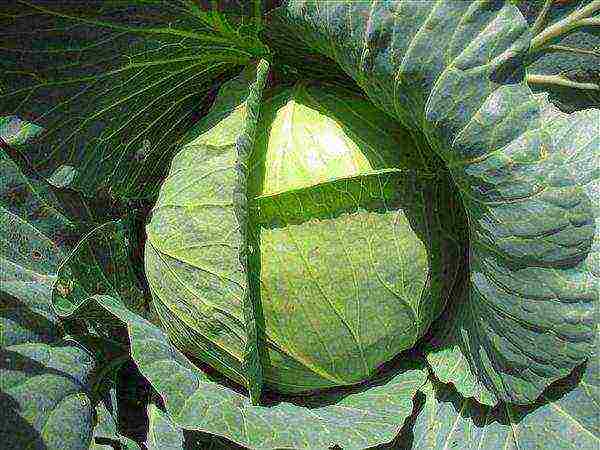 Kazachok
Kazachok
June - the variety is ready for planting in open ground already at the beginning of May, after 45-50 days you can harvest. The structure of the head is of medium density, the weight reaches 1.4-1.7 kg. When grown on highly fertile soils, the weight of a head of cabbage reaches 5 kg.
The layout of the holes when planting: 3-5 plants per 1 m2. Cabbage is distinguished by the amicability of the emergence of seedlings and excellent taste.
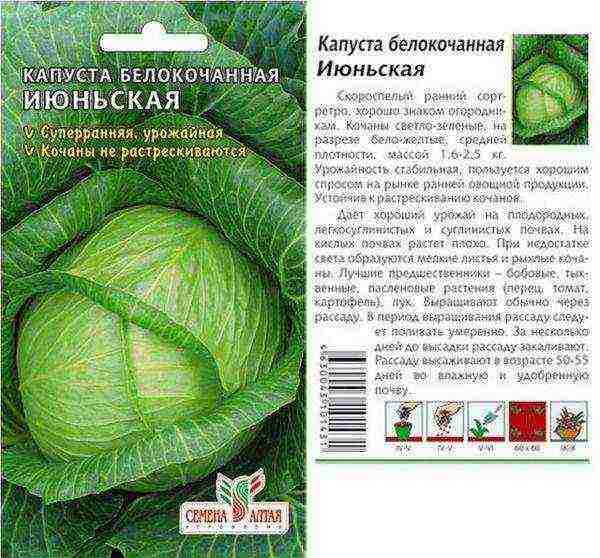 June
June
Tobia Is a Dutch hybrid characterized by resistance to fusarium wilt. The layout of the holes when planting: 2-3 plants per 1 m2. Dark green round-flat heads weigh up to 7 kg. Fruit ripening occurs later 85-90 days after disembarking seedlings.
It has a strong root system, if the irrigation regime is violated, the head of cabbage does not crack. It retains its taste and marketability for 5-6 months.
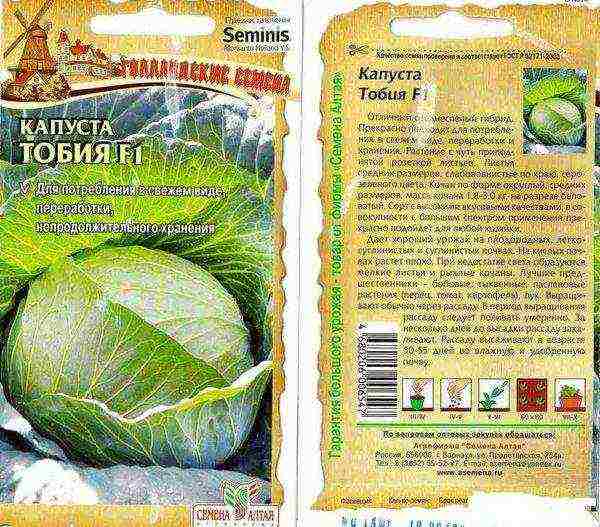 Tobia
Tobia
Varietal variety will ensure yields even in difficult weather conditions, because each plant has its own immunity to diseases and pests. The taste qualities of the varieties stimulate new experiments, which continue already in the kitchen.
Using my experience, reviews of gardeners from the forum and neighbors in the country, I will list here the best varieties of cabbage. Moreover, these varieties are suitable for the Urals and Siberia, as well as for central Russia.
Cabbage varieties with photos and descriptions, reviews
June cabbage, characteristic
An early ripening variety of cabbage, intended for fresh consumption, that is, immediately on the table. The heads of cabbage of this variety are round, weighing up to 2.5 kg. The color of the head is pale green with a slight waxy bloom. The density is average.
The variety is resistant to cracking. Harvesting "June" cabbage is carried out 60-70 days after planting seedlings. An important quality of this variety for the regions of the Urals and Siberia is that it tolerates frosts down to -5 degrees.
June cabbage yield: 6 kg / m2 sq.
Cabbage Zarya
The best early (118 days from germination to technical ripeness) variety of cabbage, resistant to cracking. Heads of cabbage are round, small, of medium density, weighing up to 2 kg. A variety for fresh use.
The Zarya variety gives high yields even with a low use of nitrogen fertilizers. High yield, good ripening and high commercial qualities of fruits are the indisputable advantage of this variety.
Cabbage yield Zarya: 3.4 - 10 kg from 1 sq.m.
Cabbage Express F1, description, photo
An early ripe hybrid of domestic breeding white cabbage. The period from full germination to the beginning of technical ripeness is 60-95 days.
The rosette of leaves is raised. The leaf is small, light green with a slight waxy bloom, flat.
The head of cabbage is round, of medium density, uncovered, of medium density, whitish on the cut. The outer and inner stumps are short. The average weight of the head is 0.9-1.3 kg. The taste is high quality.
Cabbage yield Express: up to 3.8 kg per sq. m.
Advantages of the hybrid: high yield of marketable products, excellent taste, friendly formation of early products.
Cabbage hybrid Express F1 is included in the State Register of the Russian Federation for the Central and Central Black Earth Regions.
Cabbage Gift, photo
One of the best mid-late varieties of white cabbage for pickling and pickling. From the moment of planting seedlings to harvest, 110-120 days pass.
Light green, dense heads of cabbage, rounded or flat-rounded, as if covered with a waxy coating. Usually their weight is from 2.5 to 4.5 kg. The variety has excellent taste and is recommended for fresh consumption and fermentation.
Cabbage yield Gift - up to 10 kg from 1 sq.m.
It is advisable to plant seedlings according to the scheme: 60 cm x 50 cm. This variety is recommended both for growing in the Urals and Siberia, and in other regions of Russia.
Cabbage Aggressor F1, description
A popular mid-late ripening (from germination to fruiting 115-120 days) hybrid of Dutch selection, with high growth rates, stable yield under any conditions and the ability to short-term storage (up to 5 months).
The head of cabbage is flat-rounded, medium-sized, leveled, dense, weighing 3-5 kg. Resistant to cracking. Does not require special care. Perfect for risky farming zones (Siberia and the Urals). It tolerates a lack of nitrogen nutrition and unfavorable weather conditions.
Cabbage yield Aggressor: 4.3-6.5 kg from 1 sq.m.
High yield of marketable products and excellent taste make Aggressor cabbage ideal for fresh consumption, pickling and pickling. The hybrid is particularly resistant to damage from thrips and fusarium wilt.
Cabbage Slava-1305, description
The classic variety of cabbage, best adapted to the most varied climatic conditions. Ripening period 85-100 days.
Heads of cabbage are round, weighing from 2.5 to 4.5 kg, dense.
This variety is considered one of the most productive medium-sized varieties of white cabbage. In addition, it is stable, cold-resistant, and transportable. It also tastes good. The dense, round heads of cabbage are light green on top and white on the inside.
Slava is the best variety of cabbage for pickling and pickling.
Cabbage yield Slava - up to 12 kg from 1 sq.m.
Cabbage Amager 611
A late-ripening variety of cabbage, ripening occurs 115-120 days after full germination. Heads of cabbage are round-flat, dense, weighing 3-3.5 kg.
Amager is the best variety of late cabbage, it is perfect for pickling. The taste only improves during storage.
Productivity of cabbage Amager 611: 5 - 6 kg from 1 sq.m.
Late Moscow cabbage
One of the most productive large-fruited cabbage varieties.
The weight of one head of cabbage is usually 7-8 kg, the limit is 15 kg. Heads of cabbage are round, green.
This is one of the best sauerkraut varieties.
Cabbage yield Moscow late: 10 - 12 kg from 1 sq.m.
Cabbage Megaton F1, description
High-yielding, medium late (102 days from germination to fruiting) hybrid of Dutch selection.
A head of cabbage is flat-rounded, dense, weighing up to 15 kg. Cabbage Megaton - hybrid No. 1 for fermentation, with high taste. Also suitable for processing and fresh consumption.
It is the most productive medium-sized cabbage hybrid. Differs in high resistance to fusarium. Demanding on soil moisture and needs high doses of fertilizers.
Megaton cabbage yield: 5.86 - 9.34 kg per sq. m.
Rinda Cabbage F1
Excellent mid-early (95-105 days from germination to fruiting) hybrid of Dutch selection.
Heads of cabbage are large, round, with a dense and thin internal structure, weighing 5-8 kg, white on the cut. The stump is small. It is intended for fresh consumption, fermentation and short storage (from 2 to 4 months).
White cabbage Rinda f1 is distinguished by the evenness of the heads, high yield in various climatic conditions, and the ability to survive for a long time on the vine.
Rinda cabbage yield high.
Cabbage Hope
Mid-season (from germination to ripening 115-135 days), a productive variety of cabbage.
The head of cabbage is flat-round, pale green, weighing up to 5 kg. Resistant to cracking. The taste is high. Recommended for fresh consumption, fermentation and short-term storage (up to 3 months). Transportability is good.
Cabbage yield Hope - up to 13 kg / m².
Cabbage Gingerbread Man
A high-yielding late-ripening hybrid variety of cabbage that ripens only 150 days after germination.
Heads of cabbage are dense, round, weighing up to 5 kg, resistant to cracking. The inner stalk is short. Heads of cabbage are green on top, white in section.
The variety is resistant to cabbage bacteriosis, as well as to fusarium leaf wilting, to white and gray rot. Cabbage Kolobok is ideal for storing it for the winter, as well as for pickling.In good conditions, the heads of this variety can be stored until May next year.
Cabbage yield Kolobok: 7 - 12 kg / sq. m.
Sowing seedlings in mid-April. It is desirable to plant seedlings in the ground 50 days old according to the scheme 50 × 70 cm.
These are varieties and hybrids of cabbage for open ground.
We recommend purchasing cabbage seeds of excellent quality in the Sady Rossii online store.
If you grow other varieties of cabbage and they delight you with excellent taste and bountiful harvest, share their names with us in the comments. After all, it is impossible to try all varieties at once, but you want to plant only the very best. If possible, attach a photo of the cabbage you have grown.
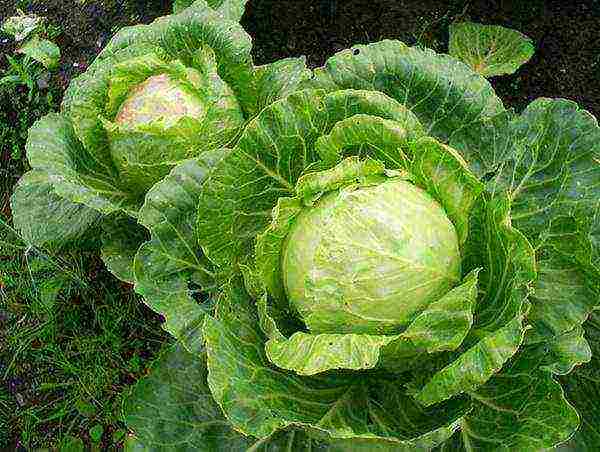
Cabbage is one of the most ancient garden crops, historians date the beginning of the cultivation of this popular vegetable in the 4th century BC. Cabbage is especially appreciated in our northern latitudes due to its cold resistance, a variety of cooking methods and its ability to keep fresh for a long time. After all, the absolute champion in popularity, potatoes, our "second bread", began to be grown everywhere only at the beginning of the 20th century. And before that, for many centuries, cabbage, along with turnips, was the most common vegetable.
Over the past 100 years, breeders have bred so many varieties of cabbage that it is not easy to understand this variety. Early varieties, varieties for pickling, for storage, zoned for different regions ... Let's take a look at the best varieties of cabbage in order. Let's start with the white one.
Early varieties of white cabbage
Early cabbage varieties have the following characteristics:
- short ripening period (90-120 days from germination), the collection is carried out in June-July, when other varieties are still developing;
- herbaceous green leaves, very tender, juicy, ideal for salads, light summer cabbage soup;
- heads of cabbage are small or even small, often loose;
- low yield,
- not stored for a long time,
- Plants are unpretentious, can grow in cramped conditions and on poor soils.
Usually, one bed of early cabbage is enough for seasonal consumption, on which it is not bad to organize a conveyor of ultra-early, early and medium-early.
Universal early varieties
Among the early varieties, a group of universal ones can be distinguished, which grow equally well in all regions of Russia. They are also the most suitable for the Far East, the south of Western Siberia, the Southern Urals and central Russia, including the Moscow region.
June
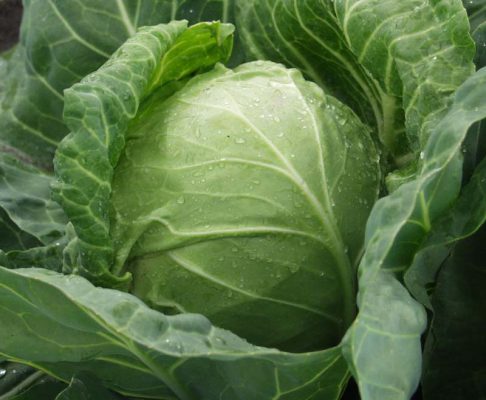
June
1967 variety from the VNIISSOK collection. The forks are very tight for an early variety. Cold-resistant, withstands early frost. Drought tolerant. Not prone to the formation of flower arrows. Heads of cabbage 1.0-2.5 kg, do not crack. The taste is delicate.
Number one Gribovsky 147
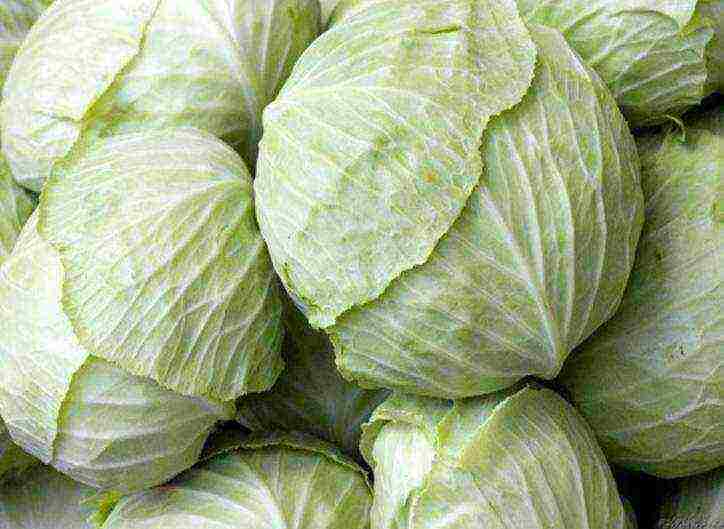
Gribovsky 147
The oldest variety of 1937, bred by VNIISSOK, ripens 1-2 weeks later than June, so it is good to plant them together to extend the season of consumption. Round forks, less often oval, can crack. It tolerates a drop in temperature and drought normally. Heads of cabbage weight 1.1-1.8 kg.
Number one Polar K 206
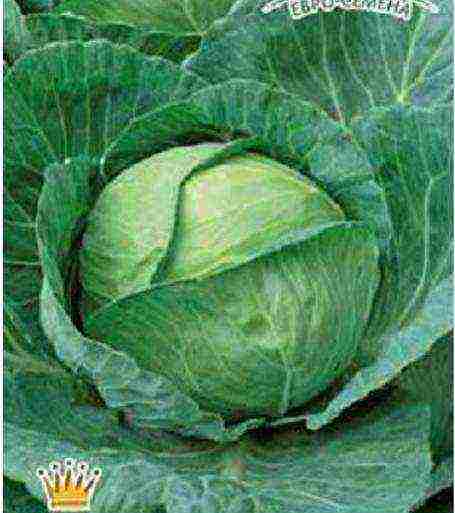
An old early variety, bred in 1937 on the basis of No. 1 Gribovsky. It ripens a week later than Gribovsky, is similar to him, but has a number of advantages:
- forms larger heads of cabbage weighing 1.9-2.8 kg,
- more yield (4.7-5.9 kg / m2),
- ripens at the same time, which makes it possible to increase the period of consumption;
- when grown in the Far North, it is used for fermentation and storage fresh until January.
Cossack F1
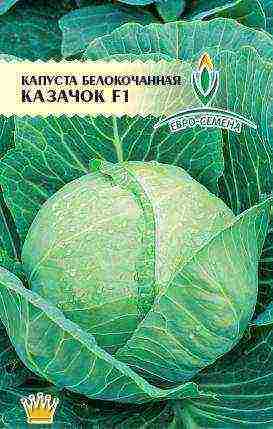
Cossack F1
This early hybrid, developed by the Krasnodar Rice Research Institute in 1994, has become very popular among summer residents and farmers over the past 20-plus years. Disease-resistant, cold-resistant, poorly tolerates temperatures above 25 degrees. Grows well in greenhouses. Heads of cabbage weighing 0.8-1.2 kg, leaves inside are yellowish-cream, do not crack. Yielding, reacts to fertilization with an increased size of forks.
Golden hectare 1432
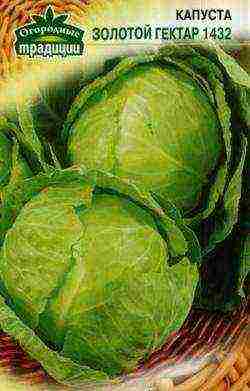
Golden hectare 1432
Medium early, very productive (5.0-8.5 kg / m2) variety, bred by specialists from the Institute named after N.I. Vavilov in St. Petersburg. It is grown both in gardening associations and in large farms. The forks are medium in density, weighing 1.6-3.3 kg. Unpretentious, resistant to drought and shooting.
Early varieties for the North, Urals and Siberia
This group includes the best varieties of cabbage, developed by breeders specifically for regions with a short northern summer - the Middle and Northern Urals, Eastern Siberia, the north of the European part and Western Siberia.
Early ripening
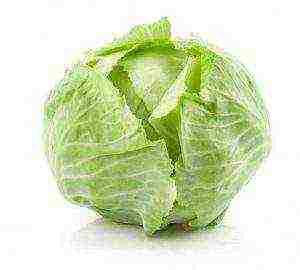
Early ripening
An old early variety, bred by the breeders of the Sortsemovosch association in 1968. In terms of ripening and taste, it is similar to June, but not so fruitful, heads of cabbage weigh only 900-1300 g. Cold-resistant, light- and moisture-loving. It grows well on peat bogs in the Leningrad Region.
Arctic F1
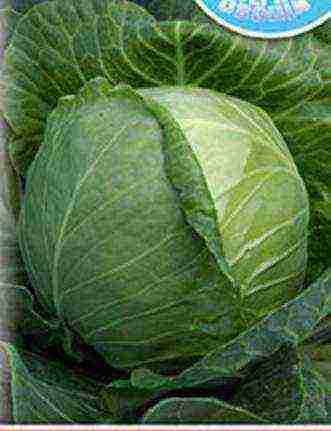
Arctic F1
Super early hybrid (90-97 days). Round forks weighing 1.0-1.5 kg. Cold resistant.
Junior F1

Junior F1
New, but already very popular mid-early hybrid from Syngenta. The State Register recommends growing this variety in the North-West, the Urals, the Volga-Vyatka region and Eastern Siberia. Not prone to fusarium wilt. Forks weighing 1.4-1.8 kg, taste good.
Mid-season varieties
Mid-season cabbage varieties are most often grown by summer residents and villagers, as they are best suited for pickling - the favorite way of harvesting cabbage in Russia.
Distinctive features:
- the growing season is 130-170 days, they begin to ripen when the early varieties are already leaving;
- average forks density,
- leaves are juicy, white inside, contain a lot of sugars;
- high yield,
- best for pickling and canning,
- stored for a short time, at most until the New Year.
Universal mid-season varieties
Glory 1305

Glory 1305
For almost 80 years, this variety has remained the most beloved among the people, despite the huge number of new products. Sweet and juicy leaves of Slava are delicious fresh and are great for fermentation. The forks are gaining a mass of 2.4-4.5 kg. Not stored for long, 2 months.
Belarusian 455
Belarusian 455
Another popular old variety. Very good for fermentation, kept fresh until the New Year. Dense forks weighing 1.3-4.1 kg, do not crack.
Hope
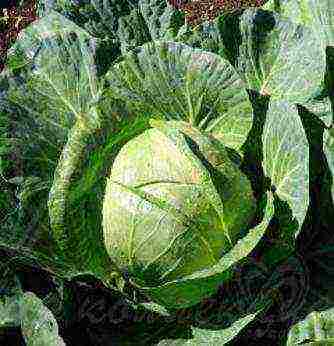
Hope
The most productive mid-season cabbage of domestic selection. Ripens in August, stored until February. Tasty both fermented and fresh. Dense forks weighing 3.0-3.5 kg do not crack. The average yield is 7.5-11.9 kg / m2.
Rinda F1
Rinda F1
Mid-season Dutch hybrid from Monsanto. The forks are dense, with a pleasant taste, and can be stored for a long time on the vine. The inner leaves are white with a yellow tint. Unpretentious to growing conditions, can be re-sown in summer. Tasty both fresh and canned. Stored until the New Year. Head mass 3.3-3.6 kg, very productive, about 9 kg / m2.
Present
Present
Medium late variety of 1960, selection of VNIISSOK. Disease-resistant, stored for 6 months. Heads of cabbage are very dense, 2.6-4.4 kg, do not crack. From one square. m you can collect up to 10 kg of cabbage. Delicious, good for pickling.
Megaton F1
Megaton F1
Medium late very productive hybrid from the Dutch company Bejo Zaden. Cold-resistant, resistant to keel, gray rot, fusarium wilt. Can be planted more densely than other varieties. Heads of cabbage grow up to 10 kg, tasty, very good when fermented. Stored until January. Suitable for growing for sale on large farms.
Mid-season varieties for the North, Urals and Siberia
Cabbage is a cold-resistant plant, it can grow normally at a temperature of 10-15 degrees. Almost all versatile mid-season varieties grow well in regions with short, cool summers. But there are several, bred specifically for the North, the Urals and Siberia.
Sibiryachka 60
Sibiryachka 60
Mid-season, ripens a week later than Belarusian. It tolerates cold snaps well. The forks are moderately dense, weighing 2.1-4.3 kg, do not crack.Good both fresh and sour. Stored up to 4 months. Productivity 3.4-8.6 kg / m2.
Florin
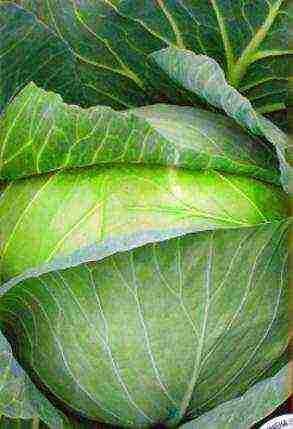
Florin
Middle late, zoned for Eastern and Western Siberia. Rarely gets sick. Dense forks weighing 2.3-4.5 kg, do not crack, good taste. Florin is grown for winter storage and fresh consumption.
Late varieties of white cabbage
A group of varieties with the longest growing season, they are grown for storage and for consumption in winter and spring.
Characteristics of late-ripening varieties:
- long growing season (160-210 days pass from germination to ripening),
- tough leaves with a low sugar content, sometimes with a bitter taste;
- the taste becomes more pleasant during storage,
- the forks are very tight,
- stored in a cool place for up to 7 months.
Universal late-ripening varieties
Amager 611

Amager 611
Bred by employees of the VNIISSOK Institute in 1937. Transfer frosts down to -5-8 degrees. It is slightly affected by insects, but often gets sick with vascular bacteriosis and fusarium wilting. Moisture-loving, does not tolerate heat well. The forks are very dense, weighing 2.6-3.6 kg, they are guaranteed to be stored until April, and under good conditions until June. The leaves have a bitter taste that disappears by spring.
Moscow late 15
Moscow late 15
Bred at the Gribovskaya vegetable selection station in 1937. Cold-resistant, not damaged during early and late frosts. Reacts very well to watering and feeding. Dense forks have a mass of 3.5-5.0 kg. An excellent variety for fermentation. Grown in commercial quantities.
Valentine F1
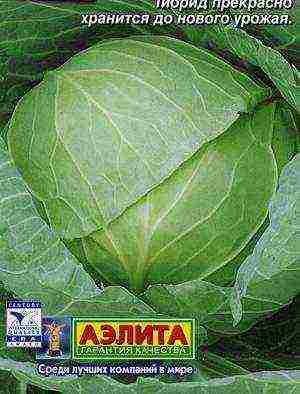
Valentine F1
Popular new hybrid. Very late. The originator is the selection station named after N.N. Timofeev. Resistant to fusarium wilt. The forks are very tight, weighing 3.0-4.0 kg. The leaves are juicy and sweet. Stored until July. Good pickled, fresh, stewed, in soups.
Lennox F1
Lennox F1
Late maturing Dutch hybrid. The forks are dense at 1.6-2.4 kg, do not crack. It is recommended to eat it fresh or leave it for winter storage.
Extra F1
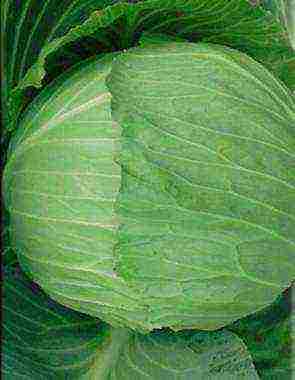
Extra F1
Late ripening disease-resistant hybrid. The harvest ripens 154-170 days after the shoots have appeared. The forks are very tight, weighing 2.5-2.8 kg. The taste is good, the cabbage is stored until May.
Late varieties for the North, Urals and Siberia
Since the summer is short in Siberia, the Urals and the North, there are very few zoned late-ripening varieties that have a long growing season. However, the best versatile cabbage varieties can be planted in these areas as well.
Orion F1
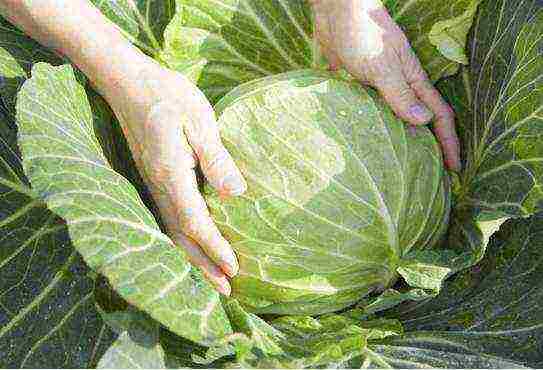
Orion F1
Zoned across Eastern Siberia and the North Caucasus. The forks are round, slightly elongated, very dense, weighing 2.3 kg, do not crack. The inner leaves are white with a creamy tinge. Good taste, can be used for fermentation. Stored up to 9 months.
Cauliflower varieties
Cauliflower differs markedly from white cabbage; this species feeds on inflorescences, not leaves. They are more nutritious, but they are a little more difficult to grow. The right choice of cauliflower variety will help you get a good harvest. Since there is usually not enough space in greenhouses, consider which ones are most effective for growing outdoors.
Early varieties of cauliflower
Movir-74
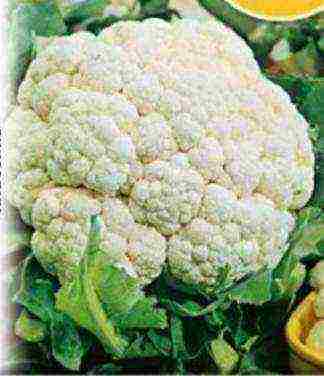
Movir-74
An ancient early variety, included in the register in 1969. Ready for harvesting 50-55 days after transplanting. Cold-resistant, drought-resistant. Heads of white or yellowish-white color weighing 500-1400 g. Fast ripening period allows you to get 2 crops per season.
Snowball 123 (Snow globe)
Medium early French variety. It is not affected by diseases, it grows well both in greenhouses and in open ground. The heads are snow-white, very hard, weighing 600-800 g.
Fremont F1
Mid-early hybrid from Monsanto. Ties heads perfectly even on very warm nights. The heads are closed, smooth, dense, without germinating upper leaves, large, weighing 1.5-2.0 kg. The taste is excellent.
Mid-season cauliflower varieties
Parisian
Mid-season cold-resistant variety. The heads are dense, weighing 750 g. The taste is good.
Purple ball
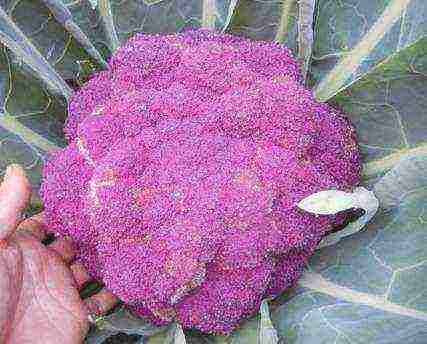
Purple ball
Very unusual plants, they combine high decorativeness and good taste. They will become a decoration of the cottage due to the bright purple color of the heads. The heads are dense, weighing 900 g, rich in anthocyanin.
Amerigo F1
Medium late hybrid. Cold-resistant, easily tolerates early frosts. Heat resistant. The heads are covered with dense white, weighing an average of 1.5 kg. It tastes great.
Another variety that has a decorative effect, in addition to good taste. Beautiful yellow-green heads weighing 400 g. Medium late in terms of ripening.
Late varieties of cauliflower
Skywalker F1
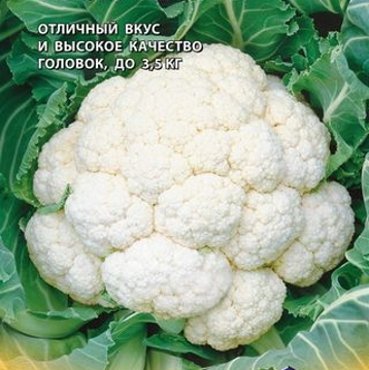
Skywalker F1
This hybrid is valued for its high yield, 3.5-5.6 kg / m2. The heads are dense, whitish, covered with leaves, weighing 1.9-3.5 kg. The taste is wonderful.
Cortez F1
Another late yielding hybrid from the Dutch company Syngenta. The head is covered with leaves, dense white, weighing 0.6-2.0 kg. The pulp is juicy and tastes good.
All of the above cauliflower varieties are universal, they can be grown throughout Russia.
Features of growing cauliflower
In general, the cultivation algorithm is almost the same as that of white cabbage. But there are also features that cannot be ignored:
- the soil needs to be well fertilized;
- fertilizing with boron and molybdenum (boric acid, potassium magnesium) is mandatory;
- during the ripening period, you need to break the upper leaves, covering the heads from the sun (the new Dutch varieties have self-covering heads);
- overripening should not be allowed, otherwise the heads will darken, become loose and bloom.
If there is enough space on the site, then it is advisable to plant the best varieties of cabbage of different ripening periods suitable for the area in order to have this delicious vegetable on the table throughout the year. In June and July - early, from August to New Year - mid-season, from January to May - late varieties of cabbage. And do not dwell on white cabbage, try to grow colored, broccoli, Brussels sprouts, red cabbage, kohlrabi, Savoy, Beijing, leaf. They are all very different, and each is tasty and useful in its own way.
Video
Many summer residents and gardeners especially appreciate the quality properties of white cabbage. Therefore, this type of vegetable crop is one of the most often grown in beds and gardens.
As historians note, white cabbage was first planted back in the 4th century BC. Over a long period, it has changed, although up to 2 years A.D. there were about 5 varieties. Basically, new varieties of white cabbage appeared only at the beginning of the twentieth century. It was then that active selection work began.
Today, the best varieties of white cabbage can be distinguished according to various indicators and properties.
Before choosing the required type of large-headed vegetable, you need to clearly define what it is for. It should be noted that early, middle and late varieties of white cabbage are intended for different consumer purposes.
For example, early cabbage does not store for a long time, has a very good and delicate taste, and has resistance to shooting. It is intended for fresh summer consumption, or for preparing other dishes. The best variety for this is the Golden Hectare. The varieties that ripen later can be stored longer, are also resistant to high summer temperatures, and have an average shelf life.
Late varieties should be planned for long-term storage. They develop slowly. The growing season passes without much care (you only need to fertilize and water on time). They are resistant to cold weather and pests. Late varieties of white cabbage are also intended for pickling. They are often grown by entrepreneurs for sale during the winter part of the year.
What are the varieties of white cabbage (see.photo with title) should you choose to get a good harvest and satisfy your needs?
The best varieties of white cabbage:
- Malachite. It is the earliest variety of white cabbage. Has small heads. The weight of one of them does not exceed two kilograms. Very juicy and spreading cabbage. The structure is moderately dense. The head of cabbage is hard. Grows well in temperate and warm climates. Loves frequent watering. Growing fast. If planted in a greenhouse, the growing season can be reduced to 5 days.
- Taurus F1. A popular early variety of white cabbage. Summer residents are very fond of growing it in their garden, since the fruits in a short period of time and subject to all the rules and principles of cultivation, reaches a weight of about 6 kg. Among the advantageous properties, it should be noted resistance to many diseases and pests. The growing season lasts up to 100 days. The Taurus F1 cabbage variety can be grown in temperate climates.
- Dobrovolskaya. One of the most productive, juicy and sweet varieties. The weight of one head can reach a record 8 kg. On average, fruits are harvested weighing 5 kg. Belongs to the category of mid-season varieties of white cabbage. Mid-season cabbage is used for food and is intended for the preparation of many dishes. It is grown for sale by agricultural enterprises. Many varieties have good keeping properties. The uniqueness of the variety is that it is endowed with natural properties of protection against many diseases and pests. Thanks to this, the summer resident can count on high yields. The shelf life of Dobrovolskaya cabbage is almost six months (up to 5 months).
- Present. The vegetable is very tasty, juicy and nutritious, has a spicy zest. It is easy to recognize among other varieties, since the surface of the green leaves has a slight waxy coating. The weight of one fruit does not exceed 4 kg. The advantage of the Gift variety is that it lends itself well to transportation without losing its shape. It is widely used for pickling and fermentation for the winter. Many are positioned as the best variety of medium-ripening white cabbage.
- Krautman F1. A hybrid variety, which has a dense structure of the fruit, weighing up to 5 kg., Has a small stump. Heads of cabbage do not crack even under abrupt changes in weather conditions. Delicious, pleasant vegetable is great for complex salting, preservation and fermentation. It is one of the kilo-resistant varieties of white cabbage.
- Geneva. Excellent late-ripening variety, ripening period - up to 140 days. One of the earliest among the late varieties. It has many advantages (good keeping quality, is not damaged during growth, has a dense structure, is transportable). Can be stored until a new harvest.
- Moscow late. Description of the Moscow late white cabbage variety will allow every summer resident to understand why it is one of the best. It is only necessary to announce the parameters of its heads of cabbage - they can reach a weight of 8-10 kg. The rosette at the head is large and rather spreading. The fruit has a rounded flat shape. It is resistant to many diseases, especially keel. A relatively frost-resistant variety that can withstand temperatures as low as 50C. Stores well until the next harvest. Heads of cabbage are dense, therefore they are easy to transport. This is the best late variety of white cabbage.

